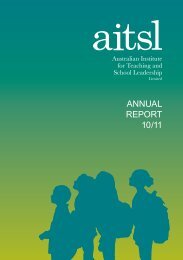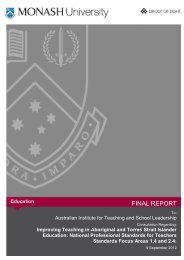Professional Learning Flagship Program: Leading Curriculum Change
Professional Learning Flagship Program: Leading Curriculum Change
Professional Learning Flagship Program: Leading Curriculum Change
Create successful ePaper yourself
Turn your PDF publications into a flip-book with our unique Google optimized e-Paper software.
The processes of leadershipThe idea of leadership is neither precise nor unified, reflected in the fact that Yammarino, Dionne, Chun,and Dansereau (2005) identify 21 leadership approaches that have been the subject of research. In themanagement literature this range can be placed on a continuum from administration to managementto leadership, with the last being more ‘visionary, creative, inspirational, energising’ than the other roles(Thorpe and Gold 2010). From this perspective, management focuses on setting targets, planning,creating organisational structures, and setting up control systems to solve problems and correct errors,while leadership involves envisioning futures and strategies for achieving them; engaging people in thevision, empowering, motivating and inspiring them to act; and ensuring recognition and reward.The general literature on individual leadership traces the concept through the charismatic to thetransactional to the transformational leader (Sarros 2008). Charismatic leadership can sometimessimply depend on attributions of leadership qualities by followers, and even its more authentic forms canrely on leader dominance and the ideological compliance, if not subservience, of followers, features thatare inappropriate for the professional context. Transactional leadership operates on the basis of rewardcontingent on satisfactory work, and consists largely of corrective action for mistakes, and could be seenas relatively routine.On the other hand, transformational leaders are said to ‘achieve performance beyond expectations bytransforming followers’ attitudes, beliefs, and values as opposed to simply gaining compliance’ (Sarros2008, p. 17), and to ‘inspire followers to perform beyond expectations while transcending self-interestfor the good of the organization’ (Avolio, Walumbwa and Weber 2009). Avolio, Walumbwa and Weber(2009, p. 423) also identify a related concept, which they call authentic leadership, as ‘a pattern oftransparent and ethical leader behaviour that encourages openness in sharing information needed tomake decisions while accepting followers ‘inputs’. Transformational leadership is in part a response tothe increasing complexity of organisations, but also a means of maximizing individual and group talent,expertise and initiative. Consequently, transformational leadership is widely seen as the most desirableof current approaches to individual leadership.The features of transformational leadership (Sarros 2008) are:• Idealised influence, when leaders act as role models and are respected and trusted by followers;• Inspirational motivation, providing meaning and challenge to work as well as optimism aroundshared visions;• Intellectual stimulation, stimulating innovation and creativity by questioning assumptions, reframingproblems and practising and encouraging new ways of thinking about problems;• Individualised consideration, addressing individuals’ needs for achievement and growth and newlearning opportunities.Illustrating the lack of consensus over terminology, Denning (2010 p. 12) describes a radicalmanagement model which looks very like transformational leadership: ‘To ensure the high performanceof self-organizing teams, radical management organizes work in client-driven work cycles; with valuedelivered to clients during each iteration, in an environment of radical transparency; continuous selfimprovementand interactive communications’.In education, research and development on leadership and management have followed a similartrajectory, and produced a range of models based on different institutional analyses leading to differentemphases and approaches. Bush (2003) describes models which focus on:• organisational structures (a form of transactional leadership)• systems models stressing the unity and coherence of the organisation• bureaucratic models dominated by concerns for maximum efficiency through rational hierarchicalmanagement approaches characterised by division of labour, rules and regulations and<strong>Professional</strong> <strong>Learning</strong> <strong>Flagship</strong> <strong>Program</strong>: <strong>Leading</strong> <strong>Curriculum</strong> <strong>Change</strong>: Literature Review 18
















